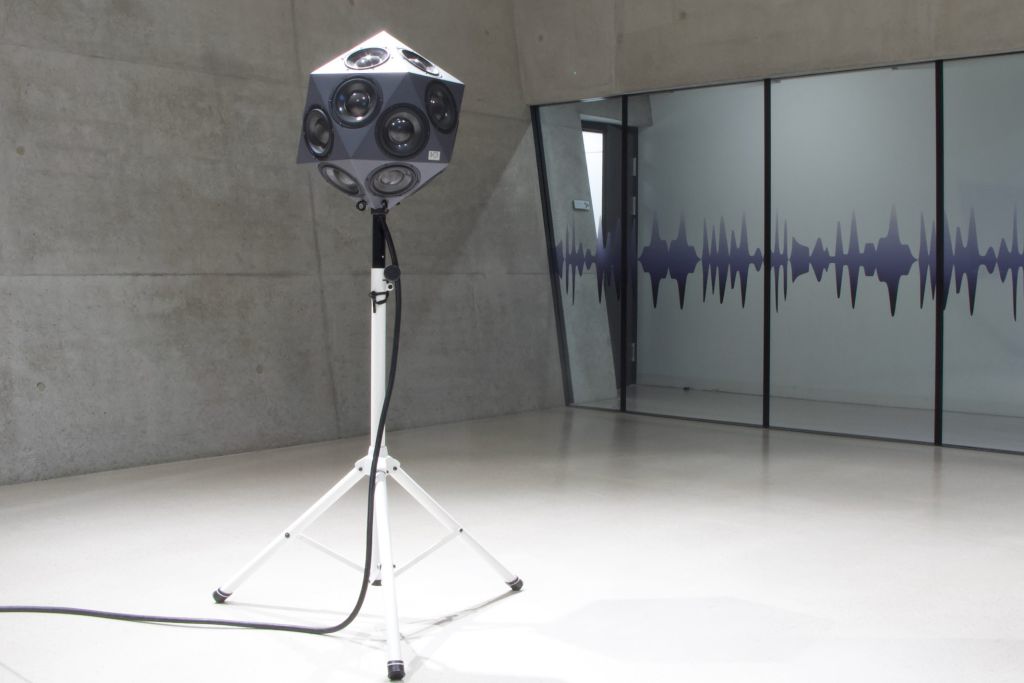The infrastructure research project Applied/Experimental Sound Research Laboratory (ÆSR Lab)1 (2023–2026) is a collaborative effort of the University of Applied Arts, the mdw (Artistic Research Center and Department of Composition Studies and Music Production), and the Phonogrammarchiv of the Austrian Academy of Sciences that is funded by Austria’s Federal Ministry of Education, Science and Research in cooperation with the EU’s Recovery and Resilience Facility (RRF).
This project embodies an initiative to develop a mobile and modular sound research lab situated at the interface of art and science, in the process facilitating interdisciplinary research and artistic creativity as well as the development and testing of new technologies. At the mdw, the component project entitled Sound Projection Lab (ÆSR SPL)2 is being conducted under the leadership of Thomas Grill with coordination by Jonas Hammerer. The focus here is on realising mobile and modular technologies for sound recording and projection as well as on the resulting experimental forms of interaction between room acoustics and musical compositions and performances. In terms of sound projects, technologies for beamforming, ambisonics, and wave field synthesis (WFS) are being implemented—but the system under development will also offer flexibility for free and unorthodox approaches to arranging and controlling loudspeakers. At present, the objective is to create 16 compact 16.1-channel modules that can be used individually (to amplify electroacoustic instruments or sound art projects) or in combination, comprising up to 256 audio channels in total. With this equipment, it will be possible to realise complex and immersive sonic architectures commensurate with the current state of research. In order to gather material for compositions based on these technologies, the options for recording are also being expanded—in particular by ambisonic and holophonic miking techniques.

The objective is to equip university teaching as well as individual students with relevant, up-to-date, and flexibly applicable tools that facilitate experimental approaches to composing and sound art. Alongside these technical components, the project will also establish an open platform for interuniversity exchange pertaining to sound art and experimental music. This three-year project is divided into one year each of work on hardware development, sound projection algorithms, and artistic applications. Apart from the procurement of a small amount of commercially available equipment such as an omnidirectional speaker and microphone for ambisonics, the lion’s share of the relevant equipment will be developed in-house. Special attention is being paid here to principles that have crystalised based on experiences in connection with the Electroacoustic and Experimental Music (ELAK) certificate programme: the first priority is the generation of lasting know-how, for which reason these projects are being developed from the ground up as part of research and teaching (including specific electives) with the involvement of students, teaching faculty, and interested parties from outside the mdw (especially from partner institutions). This process will include dealing with speaker construction, networked audio, and digital amplification technology as well as various sound projection algorithms. The knowledge gained will be documented in the best possible manner, with the results made public as “open hardware and software” in order to facilitate reproducibility and engagement by a broader community. This will hopefully also help catalyse a number of international cooperative efforts that have already been initiated. An online repository3 contains the documentation (updated on a continual basis) as well as the construction plans and software packages that have been produced so far.4,5
Even though the developed hardware technologies fulfil high standards of quality, they can still be produced at a fairly reasonable cost using easily accessible means (i.e., maker tools such as 3D printers). Acquisition costs typically constitute a major obstacle for teachers and students in their realisation of elaborate projects. The developments funded by this project are therefore intended to drastically and sustainably reduce this cost factor. The lion’s share of the artistic applications is only planned for realisation during the project’s third year. But even so, multiple presentations are planned in the near future for which prototypes of both technology and its artistic application are being developed. Fixed dates include the Long Night of Research6 on 24 May at the mdw’s Future Art Lab, the Medienfrische Festival7 from 31 May to 8 June, and cooperative activities during the week of 5–11 August as part of the Salzkammergut region’s term as a 2024 European Capital of Culture.8

